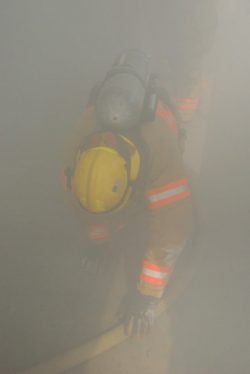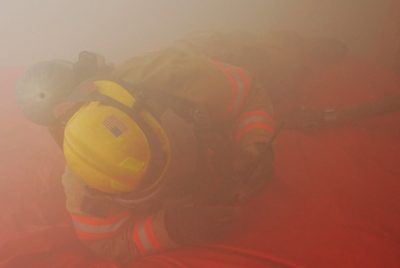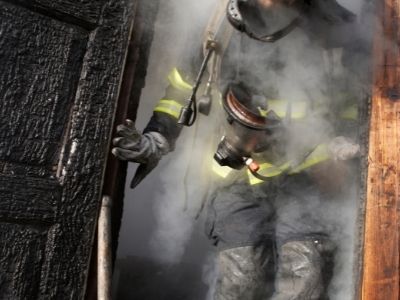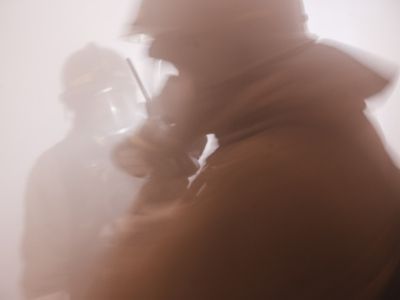Sometimes even firefighters need assistance, but who’s willing to go in and help them? The ones that do comprise RIT or RIC teams. What does that acronym stand for and what else does an RIT/RIC team member do?
Rapid intervention teams (RITs) or rapid intervention crews (RICs) are teams of firefighters who act as standby rescuers on a fire scene. Their duties involve monitoring the situation and aiding in firefighter and civilian rescue if necessary.

There’s plenty more to discuss about RIT/RIC teams, including the tools at their disposal, the regulations on their assembly, and why these teams are so integral in a fire department. Make sure you keep reading, as you’re not going to want to miss this!
Table of Contents
What Is a RIT/RIC Team and What Do They Do?
Firefighters are highly self-sufficient. They have to be, as it’s risky for others besides firefighters to safely go into a burning building. That’s why firefighters are always chosen to be part of what are known as firefighter assist and search teams or FAST.
Other names for a FAST team are rapid intervention teams or RITs or rapid intervention crews or RICs. These teams are sometimes referred to as rapid intervention dispatch or RIDs as well. We’ll call them RIT teams moving forward.
RIT teams consist of at least two firefighters, but the team might be more robust depending on the scenario at play.
What does an RIT team do? They’ll monitor an ongoing fire as other firefighters actively combat the blaze. If the active firefighters are in distress, then the RIT team would intervene.
Only certain types of fire events call for the involvement of RIT teams. These scenarios include the following:
- Structural fires: A structural fire is a fire affecting any type of industrial, commercial, or residential building and encompasses everything from barn fires to house fires. The National Fire Protection Association or NFPA divides structural fires into several subcategories:
- Type I Structural Fire: A Type I fire is fire-resistive, which means the building has passive fire protection. Type I classification is common in high-rise buildings since the steel or concrete building skeleton can handle high temperatures and fire exposure.
- Type II Structural Fire: If the fire is a Type II, it’s a non-combustible fire. The buildings under this classification have steel rafter roofs, such as in shopping malls found in strip centers.
- Type III Structural Fire: The third type of structural fire under the NFPA is an ordinary construction fire. The buildings affected have wooden frame floors and brick and mortar walls, including city rowhouses.
- Type IV Structural Fire: A Type IV structural fire is a heavy timber fire, such as at a community center or a church.
- Type V Structural Fire: The fifth type of structural fire is a wood frame fire. Under this classification are four-floor garden apartments, townhouses, and single-family homes, especially newer homes.
- SCBA-assisted fires: SCBA stands for self-contained breathing apparatuses. Whenever firefighters need to supply their own air in a fire, the severity of the blaze is greater. An RIT team should be on especially close watch.
- Fires with risk of structural collapse: When a fire grows enough, it can take down an entire building. An RIT team will be ready to intervene and rescue the firefighters before the building can collapse.
- Fires where the firefighters are at risk of getting stuck: During some fires, a firefighter’s entry and exit points can get blocked off by falling structures or growing flames. In these life-or-death situations, the assistance of an RIT team is especially appreciated.
- Fires where the firefighters could become entangled: Risks of entanglement are another instance in which an RIT team should be ready to assist. Firefighters cannot move freely when they’re trapped in a part of the building, and again, their lives can be at stake.
The Steps an RIT Team Follows
To ensure their jobs are done quickly and adequately, the RIT team and especially the team manager should follow protocols. Here is an overview.
Receive Orders
The RIT team manager should contact the incident commander or IC to check the situation status and the accountability of the active firefighters in a building. The IC is the one to issue orders, not the RIT team manager. The manager follows orders that they then pass along to the rest of the RIT team.

The IC will indicate to the RIT team manager where the rescue should occur. They’ll also select a radio channel or channels for the team manager and the rest of their RIT team to communicate with the IC.
Create a Chain of Command
Next, it’s time to assign tasks to the rest of the RIT team. This chain of command ends with the IC.
Review the Building Plan
If there’s enough time, the IC or RIT team manager might issue a building survey or pre-plan for the rest of the RIT team to evaluate. Having the building survey allows the RIT team manager and the IC to plan the best means of entry and escape from the building.
Do a Building Size-up
Then the RIT team will be off to the building in question. The IC might be in tow, but they could stay back at the fire department and communicate with the RIT team manager using radio. When the RIT team arrives at the site of the fire, they’ll assess the building for several criteria.
Those criteria include:
- Whether fire reports were issued for the site of the fire
- Where the interior fire crews are in the building
- How far the fire has spread and how large it has become
- What the weather is like
- If the building has any basements, how many, and where they’re located
- If the building has elevators versus stairwells, how many, and where they’re located
- What the interior finish contents are
- If the building has a history of fire
- If the building contains security bars
- How many floors the building has
- The condition and size of the building
- How likely the building is to collapse
- How old the building is
- What the building’s roof condition is
Check Radio Traffic and Monitor the Situation
The RIT team will continue to stay in touch with the IC throughout the incident. The RIT team manager will listen to radio traffic to determine what their next steps should be if anything. As we mentioned, the steps will be issued by the IC. Should the fire situation worsen or otherwise progress, the RIT team manager will indicate that to the IC.
Brief Other Team Members
Since the RIT team members can scatter about the base of the building or even enter the building for rescue operations if necessary, they must be able to quickly and easily communicate with each other. That’s what their radio is for. The RIT members will update one another on what they’ve learned about the fire, the status of the firefighters inside, and if the situation is growing more hazardous.
Soften the Building
To soften a building means the RIT team will take off a window’s security bars and break down doors using forcible entry. The RIT team can now easily get into the building if they have to do a rescue.
Firefighters might be able to rescue themselves thanks to the points of entry and exit the RIT team created.

Usually, only one member of the RIT team will soften the building while the others take care of other tasks. By accessing a previously closed door, the RIT team member can now investigate the area. Victims and firefighters eager to escape might be near a door but unable to get out, so they won’t be far away, and rescue should transpire easily.
Before closing a door and moving on, the RIT team member who opened the door must have a means of closing the door without it locking. Maybe they put a rubber lock cover on the handle or use another method, but the door must remain a point of entry and exit for anyone in the building.
Maintain Hose Line
If the fire department’s hose line kinks up, then the firefighters will lack the appropriate water pressure to do their jobs. Due to the very active nature of a firefighter’s duties, they might not notice hose line kinks or obstructions, but the RIT team can and should. They must be ready to unkink the line as needed.
What Tools Do an RIT/RIC Teams Use?
An RIT team does not run into an active fire empty-handed, of course. That would be plainly dangerous. Here are the tools that an RIT team must not go without.
Radios
We touched on this in the last section, but radios are a crucial means of staying in touch with the IC as well as other members of the RIT team, including the team manager. Every member of the RIT team needs their own radio. It should be tuned to the appropriate channels.
Spare Air
If a firefighter’s SCBA equipment runs low on air or if all the air is depleted, they could risk asphyxiation from the choking dark smoke a fire creates. An RIT team can deliver spare air supply tanks to the firefighters.
Forcible Entry Tools
One assigned member of the RIT team must have forcible entry tools on their person such as axes, Halligan bars, crowbars, pulling tools, or sledgehammers. As you learned, the RIT team member uses these tools to remove window bars and open doors.
Thermal Imaging Cameras
A thermal imaging camera allows a firefighter to see in ways their eyes cannot, especially when billowing smoke obstructs their vision. Ideally, every member of the RIT team should have a thermal imaging camera to aide them in search and rescue operations.
Flashlights
Although it’s a basic tool, a flashlight can save lives as it illuminates dark corners where downed firefighters or civilians might be injured or even unconscious.
Ground Ladders
The last tool common of RIT teams is at least one ground ladder. For multi-story buildings, a ladder is a quick way to reach the upper stories, especially if the stairs or elevator are impacted by the fire.
What Are the NFPA Regulations on RIT/RIC Teams?
As a leading fire authority, the NFPA produces guides on RIT team rules. The NFPA 1407 Standard for Training Fire Service Rapid Intervention Crews was published in 2020 and is the latest edition of the NFPA guidelines as of this writing.
In the guide are training procedures for new firefighters or those who have been a part of the fire department for a while but are aspiring to join an RIT team.
Why RIT/RIC Teams Are Important?
Why should a fire department have an RIT team in the first place? Isn’t it taking away from the number of firefighters who can actively put out fires?
It all goes back to what we mentioned in the intro. Firefighters are not invincible. Even with pre-planning and surveys, conditions can rapidly change in a fire, leaving a firefighter stranded in a dangerous situation with no way out.

It doesn’t matter what kind of equipment they have on the fire truck; if a firefighter is stuck in a room on fire without an exit, they too could succumb to serious injuries and likely death just the same way any civilian could.
Firefighters don’t always need the assistance of an RIT team, but when they do, that assistance is invaluable. It can give firefighters a sense of confidence to know that if a fire progresses beyond a certain point, they have a ground team that’s overseeing the conditions and will enter the building for rescue.
In short, RIT teams save lives, both the lives of firefighters and civilians. That alone proves how important an RIT team is!
Rapid intervention team or RITs, also known as RICs or RIDs, are a type of firefighter assist and search team that will scope out conditions and then forcibly enter a building. Their duties are to create access points for firefighters, monitor changing conditions during a fire event, and rescue firefighters and civilians.
With RIT teams at the helm, firefighters can do their jobs much more safely and efficiently.